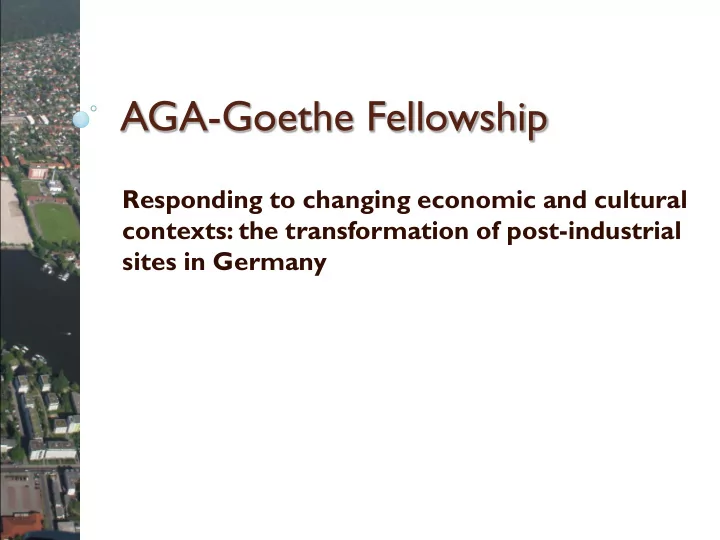

AGA-Goethe Fellowship Responding to changing economic and cultural contexts: the transformation of post-industrial sites in Germany
Presentation outline Fellowship goals Rationale Context Research question Method / approach Evolution of project ◦ Case studies ◦ Additional information collected Communicating results and list of meetings
Fellowship goals Project goals ◦ To draw lessons and best practice from post-industrial sites in Germany’s cities to inform urban renewal opportunities and implementation in Australian cities. ◦ To draw lessons and best practice from post-industrial sites in Germany’s regions to inform the transition to a low -carbon economy for the Latrobe Valley and other trade-exposed, industrial areas around Australia. Personal goals ◦ To improve my knowledge of the German language (particularly in business), culture and politics. ◦ To conduct high quality, timely and relevant research that is clearly reported and results in better planning outcomes, and improved knowledge exchange and relations between Australia and Germany.
Rationale
Vic context
Research Question How has Germany transformed post-industrial sites in response to changing economic and cultural contexts?
Method / approach Synthesise Pre-reading: Stakeholder info/refine meetings (Melb) industrial redev’t research question Develop German Confirm sites and Review scope – language skills contacts urban renewal Process Conduct site visits Collect additional information and and interviews information present findings
Case studies Berlin ◦ Adlershof Leipzig ◦ Spinnerei Hamburg ◦ Hafencity Duisburg ◦ Innenhafen Duisburg
Berlin: Adlershof ‘Stadt für Wissenschaft und Medien’ Site: ◦ 420 ha ◦ 12km SE Berlin Mitte Contacts: ◦ Senatsverwaltung für Stadtentwicklung und Umwelt ◦ Adlershof Projekt GmbH
Adlershof: what it was
Adlershof: what it is today City for Science, Business and Media Germany’s largest science and technology park
Adlershof Adlershof 2010/11: • 883 companies • 14,000 employees • 7,800 students • 17 Research and Science Institutes
Adlershof: key success factors Government investment Networks: ◦ Spatial proximity facilitated development of links and communication ◦ Synergies – Linking research and training at unis and other institutes, through to implementation, private business enterprise and production of goods . WISTA - additional services offered
Leipzig: Spinnerei From Cotton to Culture Site: ◦ 10ha ◦ 5km W Leipzig Hbf Contact: ◦ Spinnerei, Bertram Schultze,CEO
Spinnerei: what it was
Spinnerei : what it is now
Spinnerei : what it is now
Spinnerei : key success factors Quality of site Building on momentum of current activity + city strength Staged development Balance of tenants
Hamburg: Hafencity Site: ◦ 157 ha ◦ Ikm S from city centre Contact: ◦ Hafencity Hamburg GmbH, Assistant der Geschäftsführung, Hans Peter Schneider
Hafencity: what it was
Hafencity: what it is now
Hafencity: what it is now
Hafencity: key success factors LT process – didn’t plan everything at the start, able to respond to changing conditions ◦ Kept the process for development simple at the start, added in more criteria and variables as time went on Ensured a small scale mix of uses: ◦ New parts of cities need to be lively and have the capacity to change over time (uses etc). ◦ Criteria first floor be a min. 5m and not for office use, but ‘active’ use – e.g. shops, restaurant.
Duisburg: Innenhafen 89 ha site 1.5km N Duisburg Hbf Contact: ◦ Rolf Fehr, Bereichsleiter Standortentwicklung und Infrastruktur, Innenhafen Duisburg Entwicklungsgesellscha ft
Innenhafen: what it was
Innenhafen: what it is now
Innenhafen: key success factors Good master plan: ◦ Only a few rules, but stringently kept to: Service (not production); 6 floor limit for offices; as dense as possible Small but strong development organisation Funding – public investment for private interest Potential of the site
Additional information collected Ruhr region – meetings and contacts Industrial redevelopments: ◦ Landschaftspark Duisburg Nord ◦ Phoenix See – conversion of steel works to lakes ringed by new residential and commercial developments ◦ Leipzig Neuseenland – conversion of open cut mines to lakes for recreation and conservation purposes ◦ Many industrial building conversions in Berlin – often for cultural, music or artistic pursuits. Baugruppe – model for housing development Leipzig – urban renewal program T emporary uses of space (Berlin T empelhof and Leipzig Wächterhäuser)
List of Meetings / Communicating Results BERLIN RUHR REGION Australian Embassy , Günter Schlothauer Innenhafen Duisburg Entwicklungsgesellschaft GmbH, Rolf Fehr, Bereichsleiter Standortentwicklung EUROPARC Deutschland , Jan Wildefeld and und Infrastruktur Gudrun Batek, Project Officers Bottrop Innovation City Ruhr, Jan Schaare, Land Berlin - Senatsverwaltung für Projecktleiter Merketing Stadtentwicklung und Umwelt , Dominique Sandten, Project Manager Institut für Landes- und Stadtentwicklungsforschung GmbH , Herrn Humbolt University, Professor Dr Ludwig Danielzyk, Wissenschaftlichen Direktor Ellenberg and Benjamin Otto, Doctorate Student Metropole Regional Verband Ruhr , Claas Technical University Dortmund , Professor Beckford, Teamleiter Masterplanung Emeritus Klaus Kunzmann Planergemeinschaft Dubach & Kohlbrenner , Udo Dittfurth MELBOURNE Adlershof Projekt GmbH, Annette Rott, Project Places Victoria Manager Department of Planning and Community Development ◦ Regional Development Victoria LEIPZIG ◦ Heritage Victoria Stadt Leipzig , Stefan Gabi, Abteilungsleiter ◦ Planning policy Spinnerei, Bertram Schultze, CEO ◦ Spatial Analysis and Research ◦ Minister of Planning’s office HAMBURG Victorian Industrial Heritage Advisory Committee Hafencity GmbH, Hans Peter Schneider, Assistant Renew Australia der Geschäftsführung RMIT – EU Centre, and Professors and doctorate Gängeviertel , Franzi Schillig, Planner students in Planning Department
Recommend
More recommend